[Retracted] Research on Sustainable Development of Olympic Games Based on Ecological Carrying Capacity Analysis
Abstract
The Olympic Games is a comprehensive social and cultural activity with the most complicated system and the largest scale. With the development of the Olympic Games, the ecological problems brought by the Olympic Games have attracted increasing attention, and the sustainable development of the Olympic Games has been put on the agenda. Based on the comprehensive index of Ecological Carrying Capacity (ECC), Environmental Kuznets Curve, and carbon footprint analysis of the Olympic Games host city competition cycle, this study analyzes three modes of ECC of the host city: light urban ecological burden mode, heavy urban ecological burden mode, and overload urban ecological burden mode. Based on the temperature sensor and GPS positioning, the land surface temperature change map of Tokyo, Japan, from 1990 to 2015 is obtained, and the heat island effect of Tokyo is obtained. This paper analyzes the case of using sensors for intelligent event management such as venue detection in the sustainable development plan of the 2020 Tokyo Olympics; the idea and practice of thrifty hosting of 2022 Beijing Winter Olympics and 2022 Hangzhou Asian Games holds that in most cases, the ECC of the host city of the Olympic Games is under great pressure, so it is necessary to pay attention to the ECC of the host city. The sustainable development of the Olympic Games is an important issue in the development of the Olympics, but the sustainable development plan of the Olympics is still being explored. It is suggested that the sustainable development of the Olympic Games needs to evaluate the ECC of the host city in the whole cycle, establish the principle of ecological priority to avoid the overload mode of ecological burden, strive to achieve carbon neutrality in the competition, and practice the idea of scientific frugality in running the competition.
1. Introduction
The Olympic Games is a comprehensive social and cultural activity with complex system and large scale. From the bid to the hosting of the Olympic Games, huge costs need to be invested. When Albert, France, hosted the Winter Olympics in 1992, more than 30 hectares of forests were destroyed, and tens of thousands of animals and plants lost their living environment, resulting in the rapid disappearance of many local biological species. During the two weeks of the 2004 Athens Olympic Games, a total of 50 tons of CO2 was emitted, and after the whole event, the CO2 emission was about 500,000 tons, which brought a serious impact on the national ecological environment [1]. Therefore, in the process of hosting the Olympic Games, it is inevitable to consider: while maximizing the economic and social benefits brought by the competition, how to reduce the negative impact of the competition on the urban ecological environment, effectively avoid the risks of the urban ecological environment and promote the sustainable development of the ecological environment of the host city. These are the important issues for the sustainable development of the Olympic Games. Although the Olympic Agenda 2020 adopted at the end of 2014 takes reducing the cost of bidding and hosting the Olympic Games and sustainable development as important issues, it is regarded as an effective reform plan to promote the sustainable development of the Olympics. However, the high budget cost of the Olympic Games has put the thrifty Olympic Games plan pushed by the International Olympic Committee (IOC) to the test. Ultimately, the irreversible and unsustainable environmental problems such as waste of resources and ecological destruction caused by hosting the Olympic Games are the stumbling blocks to the development of the Olympic Games. Therefore, hosting the Olympic Games is not only an “economic account” but also an “environmental account.”
2. The Sustainable Development of the Olympic Games
The world sports governance system represented by the United Nations and the IOC formally brings “sustainability” into the global sports policy framework. In 2012, the United Nations designed Sustainable Development Goals (SDGs) based on sustainable theory as the strategic framework of global development from 2015 to 2030. And in article 37 of “Transforming Our World: 2030 Agenda for Sustainable Development” [2], it is pointed out that “sports are also an important factor to promote sustainable development.” In response to the United Nations concept of sustainable development, in December 2014, the IOC put forward in Olympic Agenda 2020 that “sustainability should be incorporated into all aspects of the Olympic Games and the daily operation of the Olympics.” As the most outstanding Olympic Games in the world, the Olympic Games adopted the sustainable development standards of the United Nations in resource management and took them into real actions. In 2015, as a “permanent observer,” the IOC released “The Contribution of Sports to the United Nations Post-2015 Development Agenda and Sustainable Development Goals: Position of the IOC” [3], which concluded that sports can support the sustainable development of human society. In December 2016, the IOC issued the Sustainable Development Strategy (IOC Sustainable Strategy), which promoted sustainability as the “working principle” of the Olympics and supported and implemented the sustainable development agenda of the United Nations [4]. With the implementation of sustainable development by the IOC in an all-round way, other international sports organizations also regard it as the core concept of running the Games. Table 1 shows the development of the Olympics towards sustainability.
| Years | Related key Olympic Games | Events related to the Olympics | World trends regarding sustainability |
|---|---|---|---|
| 1992 | Albertville (winter) | Albertville 1992: criticism of destruction of the natural environment |
|
| 1994 | Lillehammer (winter) |
|
|
| 1996 | Modification of the Olympic charter: incorporates “environment” and “sustainability” in the basic principles | ||
| 1999 | Olympics’ Agenda 21: sets out the basic concepts and practical activities of environmental conservation in the sports world | ||
| 2000 | Sydney (summer) | Sydney 2000: “Green Olympic Games” is a key theme | |
| 2010 | Vancouver (winter) | Vancouver 2010: advanced approach to sustainability for the games | Aichi Biodiversity Targets of the United Nations Convention on Biological Diversity |
| 2012 | London (summer) | London 2012: the first sustainable Olympic and Paralympic Games | United Nations Conference on Sustainable Development (Rio+20) ISO 20121 launched |
| 2013 | Tokyo is selected to host the 2020 games | ||
| 2014 | Olympic Agenda 2020: sustainability is included in all aspects of the Olympic Games and within the Olympics daily operations | ||
| 2016 | Rio de Janeiro (summer) | IOC sustainability strategy: sustainability is included as a working principle of the Olympics | G7 Toyama Framework on Material Cycles |
| 2020 | Tokyo (summer) | Tokyo 2020: aims to showcase a model of a sustainable society which humankind pursues and work integrally on sustainability challenges | Target year set in the Aichi Biodiversity Targets Paris agreement begins |
| 2022 | Beijing (winter) |
|
|
| 2022 | Hangzhou (Asian games) | IDEA: green, smart, thrifty, and civilized |
3. Ecological Carrying Capacity Model of Olympic Games
3.1. Comprehensive Index of ECC
In the equation, α, β, γ … … are respective carrying capacity indexes. The comprehensive application of various carrying capacity indexes can reduce the influence of human subjectivity on the results, among which fuzzy analytic hierarchy process, grey relational comprehensive analysis method, and multifactor relational analysis method [5] are also introduced into the comprehensive carrying capacity evaluation system.
3.2. Environmental Kuznets Curve (EKC)
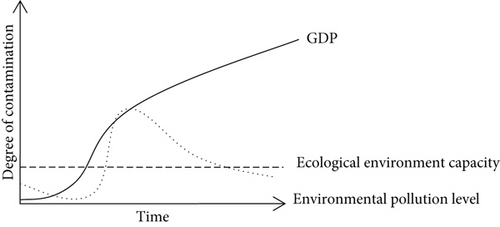
In this equation, y is the environmental pressure index; x is the economic development index; a is a constant term, usually representing the characteristic parameters of a country or region; b1 and b2 represent the coefficients of the first and second terms of x; and ε is a random error term.
3.3. Analysis of Carbon Footprint during the Event in Host Cities of Olympic Games
The IOC is the first international sports organization to propose sustainable development and introduce carbon footprint to measure the environmental impact of events. At the Olympic Conference held in Paris in 1994, the IOC specially discussed sports and environment, and in 1996, the environmental and sustainable development clauses were included in the Olympic Charter [7]. The concern of the IOC for sustainable development has directly promoted the attention of the Olympic Games Organizing Committee (OGOC) of the bid countries and host countries to environmental issues. In 2004, when London applied for the 2012 Summer Olympics, it emphasized that environmental quality and sustainable development were the key contents of London’s bid. In the 2008 Beijing Olympic Games, the IOC introduced the environmental impact assessment of carbon footprint on the Olympic Games. Subsequently, the host cities of all previous Summer Olympic Games and Winter Olympic Games attached great importance to sustainable development and adopted various measures in venues, energy use, material selection, garbage disposal, transportation, and other aspects to reduce the environmental burden of the Olympic Games. According to the requirements of the IOC, from 2030 onwards, the OGOC will be required to reduce and compensate the carbon emissions directly related to its operation, so as to ensure that the positive impact of the Olympic Games on climate is greater than the negative impact [8]. Using carbon footprint to assess the impact of the Olympic Games on the ecological environment of the host city makes it possible to analyze the environmental impact of the Olympic Games and reduce carbon emissions through corresponding measures. According to the relevant documents of Tokyo Olympic Organizing Committee, the carbon emissions of Olympic Games can be divided into three stages: pre-Games, in-Games, and after-game. In pre-Games stage, the carbon emissions mainly come from the construction of supporting facilities for the competition. During the game, the carbon emissions mainly derive from the activities related to the competition; after the game, the operation and maintenance of venues emit most of the carbon [9]. Figure 2 shows the proportion of carbon footprint in different stages of the Olympic Games.
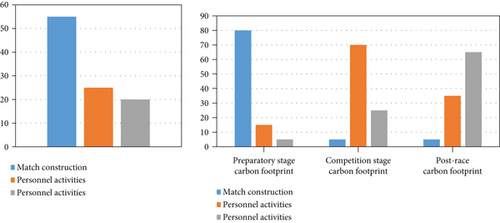
3.4. ECC Model in the Host Cities of Olympic Games
According to the threshold theory of ECC and EKC theories, this paper analyzes the relationship between the host city and the quality of ecological environment and draws the following conclusions: (1) When the impact of the Olympic Games on the ecological environment is below the warning line of ECC, then with the economic development, measures can be taken to restore the ecology. (2) When the impact of the Olympic Games on the ecological environment exceeds the warning line of ECC, but it has not yet exceeded the limit of ECC, with the development of economy, taking corresponding measures can make the ecology recover slowly. (3) When the impact of the ecological environment of the Olympic Games exceeds the ecological carrying limit, it will cause irreversible damage to the ecology. Even with the economic development, it is extremely difficult and slow to repair the ecological environment. According to the actual situation of the host cities of previous Olympic Games, the ECC of the host cities of Olympic Games is catalogued into the following three modes.
3.4.1. Light Urban Ecological Burden Mode
The first is the ideal development model. The EKC implies that the ecological threshold as an important prerequisite is large enough or the ECC is large, which assumes that no matter how serious the pollution is, it is reversible and recoverable for the ecological environment, indicating that the critical point or inflection point of the EKC always exists. As shown in Figure 3, when the carrying capacity of population, resources, transportation, and land in the development of the city hosting the Olympic Games reaches the inflection point, the degradation of environmental quality has not yet reached the threshold of ECC and is controlled within the warning line of ECC. However, after the inflection point, due to reasons such as the enhancement of environmental protection awareness of the organizers of the host city and the increase of environmental protection investment, the coercive force of the development of large-scale events on the ecological environment gradually decreases, which can realize the synchronous and benign development of large-scale events and urban ecosystem. This model depicts a bright future for the development of the urban Olympic Games; that is, the competition is well developed, and the quality of urban ecological environment is also restored.

3.4.2. Heavy Urban Ecological Burden Mode
The second is the mode of heavy urban ecological burden. As shown in Figure 4, when the overweight carrying capacity of population increases, resource consumption, environmental pollution, traffic jam, and other factors in the Olympic Games break through the warning line of ECC and reach the inflection point in conjunction with the urban ecosystem; its coercive force is within the threshold of ECC, and the trend of ecological environment degradation can still be contained in time to promote the coordinated development of the event and the city; otherwise, it will face the irreversible upward inflection point of environmental aggravation and deterioration.
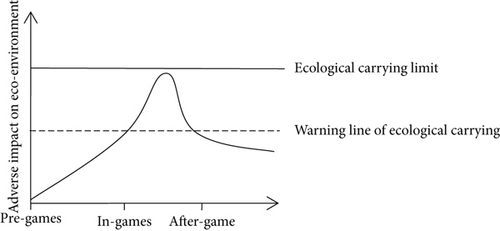
3.4.3. Overload Model of Urban Ecological Burden
The third is the overload model of urban ecological burden. The EKC depicts the relationship between economy and environment, in which the environment deteriorates first and then improves. However, people often witness that the environment in the development of sports events has not improved after deterioration, and the degree of degradation continues to rise, which ultimately affects the development of sports events. As shown in Figure 5, the initial stage of the competition is not obviously affected by the competition level and scale restrictions; that is, when the warning line of ECC is broken through, no attention is paid to it; then, when the scale of the competition expands beyond the critical point of reversibility, it crosses the threshold of ECC to automatically adjust and restore the elastic range, resulting in a series of urban ecological crises such as population explosion, resource depletion, environmental deterioration, and ecological imbalance, showing a serious overload state, which is embodied in the overload of urban traffic carrying capacity caused by population explosion, overload of urban land carrying capacity caused by excessive consumption of resources, and environmental pollution. When the development of the competition reaches the critical point, it is not only difficult to curb the serious degradation of the ecological environment quality but also makes the technical difficulty of controlling environmental pollution and ecological degradation increase, and its economic and social costs will exceed the range that the city can bear, making the economic, social, and environmental benefits unable to achieve the expected purpose.
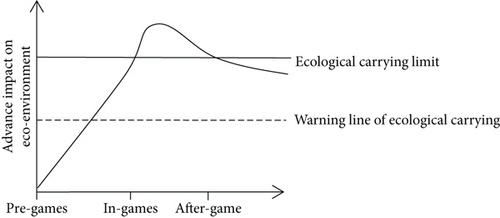
4. Practice and Feedback of Sustainable Development of 2020 Tokyo Olympic Games
4.1. Analysis of the ECC of Tokyo City
Heat island effect is an important index to evaluate the impact of human activities on the ecological environment of megacities. The Olympic Games is the most complex and largest comprehensive social and cultural activity in the world, and the host cities of the Olympic Games are almost all megacities in the world. Tokyo is a superlarge city in the world, and its impervious surfaces such as buildings and roads are distributed on a large scale and densely. In addition, a large number of human activities have produced a large amount of urban metabolism such as water and heat. This kind of “super-large” has a strong external interference on the urban ecosystem, and its urban heat island problem is far greater than that of other small and medium-sized cities and rural areas. As shown in Figure 6, through the temperature sensor and GPS positioning detection, the land surface temperature change chart of Tokyo, Japan, from 1990 to 2015 was obtained, and the heat island effect of Tokyo, Japan, was obtained. This paper uses the heat island effect to analyze the ECC of Tokyo from 1990 to 2015.
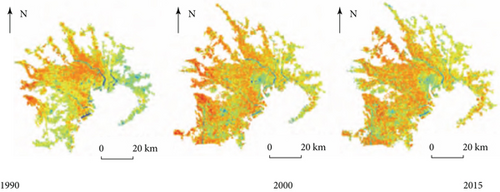
As shown in Table 2, during the period of 1990-2015, the proportion of Tokyo’s temperature rising area (35.35%) is higher than that of its temperature decreasing area (14.12%) (Table 2), which shows that Tokyo’s cities are also in a warming trend in general during the research period. During the research period, Tokyo’s cities expanded greatly, occupying a large amount of ecological land. In addition, the proposed layout model of “multi-center and multi-group” was not well implemented, and a good green separation zone could not be formed among groups, resulting in a substantial increase in the surface temperature level. It can be found that at the beginning of hosting the 2020 Tokyo Olympic Games, the urban ecology of Tokyo was overloaded. If the investment in the Olympic Games is blindly increased, it is very likely that the Tokyo Olympic Games will be overloaded, causing irreparable damage to the ecological environment.
| Changes | Ranks | Area/km2 | Proportion/% | Total proportion/% |
|---|---|---|---|---|
| Down | -4 | 2.65 | 0.05 | 14.12 |
| -3 | 15.79 | 0.26 | ||
| -2 | 231.44 | 3.86 | ||
| -1 | 596.23 | 9.95 | ||
| Level | 0 | 3027.8 | 50.53 | 50.53 |
| Up | 1 | 1398.82 | 23.34 | 35.35 |
| 2 | 553.93 | 9.24 | ||
| 3 | 139.32 | 2.33 | ||
| 4 | 22.49 | 0.38 | ||
| 5 | 3.54 | 0.06 | ||
| 6 | 0.01 | 0.00 | ||
| Total | — | 5992.02 | 100.00 | 100.00 |
4.2. Practice and Feedback of Sustainable Development Plan for 2020 Tokyo Olympic Games
From their own needs, the Japanese government and the Tokyo Metropolitan Government responded to the reform call of the IOC and made sustainability one of the most important tasks of the Tokyo Olympic Organizing Committee. The medium- and long-term goal of the Tokyo Metropolitan Government is to build it into a model of harmonious coexistence between highly developed society and environment in large cities around the world, and this long-term development vision coincides with the goal of the IOC to promote the sustainable development of the Olympic host city. As shown in Figure 7, in order to realize the sustainability vision and objectives of the Tokyo Olympic Games, the Tokyo Olympic Organizing Committee has formulated a detailed sustainability strategy and work list, which defines the key areas and specific work objectives of the sustainability work in preparation, hosting, and post-Games.
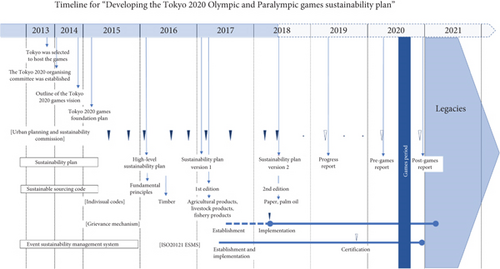
4.2.1. Active Response to Climate Change
Climate change is a major global challenge in the 21st century. It has become an international consensus and the general trend to actively respond to climate change and promote low-carbon development. The IOC clearly stated that the direct and indirect greenhouse gas emissions caused by the Olympics should be managed, and the impact of climate change should be adapted according to the actual situation of the activities [12]. In order to cope with climate change, the Tokyo Olympic Games set the goal of “zero carbon” and promised to contribute to the temperature control goal set by the Paris Agreement of the United Nations Framework Convention on Climate Change concluded in 2015. Through the use of renewable energy and energy-saving measures, it laid the foundation for Japan to build a carbon-free society and become a model for global response to climate change. As shown in Figure 8, in the field of tackling climate change, the main work included carbon accounting of benchmark emission level, determination of specific content of measures to tackle climate change and carbon management. Measures to deal with climate change were also classified into three categories: measures to avoid carbon emissions, measures to reduce carbon emissions through energy saving and renewable energy utilization, and carbon compensation measures. Through the Olympic carbon accounting work, the Tokyo Olympic Organizing Committee determined that the emission benchmark level for the whole life cycle of the Olympic Games was 3.01 million tons of carbon dioxide. In order to avoid carbon emissions, about 60% of the Olympic Games used existing facilities, which had been expected to reduce the emission level to 2.93 million tons. In addition, carbon emissions from various activities were further reduced through other energy-saving measures and renewable energy utilization measures: for example, Tokyo actively used low-pollution and energy-efficient transportation means such as fuel cell vehicles and plug-in hybrid vehicles; clean and energy-saving vehicles were used 100% during the Olympic Games to ensure that the average carbon dioxide emission intensity (G-CO2/km) generated by vehicles used in the Olympic Games was at a low level; seven permanent venues in Tokyo were equipped with renewable energy systems including about 513 kW solar photovoltaic, 462 kW solar photothermal, and about 1523 MJ geothermal. 100% of the electricity used during the Olympic Games came from renewable energy. Tokyo also made full use of the advantages of domestic hydrogen energy technology to fully use pure hydrogen energy in the planned Olympic village and its community. As shown in Figure 9, the Tokyo Olympic Organizing Committee promoted some management plans for climate issues, such as the 2020 tourism demand management plan and procurement-related management plans, so as to promote all sectors to participate in activities to mitigate and adapt to climate change and encourage people to choose a more sustainable lifestyle. The Games carbon footprint (the amount of CO2 and other emissions) was expected to be about 3,010,000 t-CO2 without any measures. However, this was reduced by about 280,000 t-CO2 as a result of implementing avoidance and reduction measures such as the use of rentals or leases, use of existing venues, renewable energy use, and adoption of energy saving facilities.
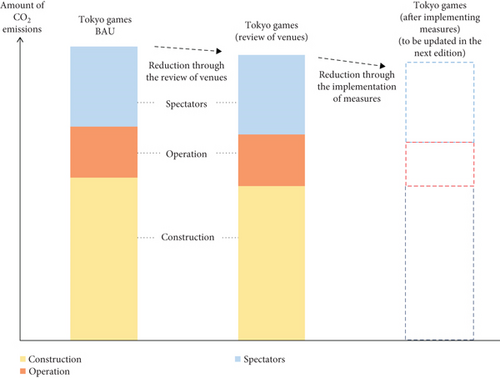
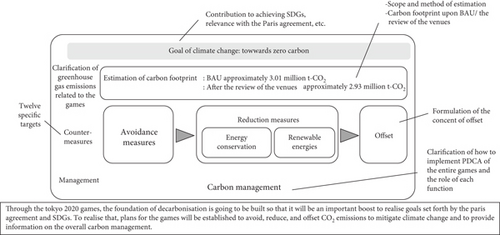
4.2.2. Effective Resource Management: The Idea of “Frugality” in Running the Competition
In order to carry out sports activities and hold sports events, it is necessary to consume a lot of resources to build sports venues, produce sports equipment, and provide energy, water, and food, as well as some technical services, such as sensor technology, are also needed as the basis for the event. Therefore, when preparing and hosting the Olympic Games, it is very important to adopt effective resource management methods to achieve the goal of sustainable development. The new main arena, the new national arena, is designed with a “Traditional and stylized”roof made of wood and steel, using wood from 47 Japanese prefectures almost everywhere inside the main arena, advocate and the surrounding environment into one of the “Forest Stadium”; the spectator did not install air-conditioning, the use of natural wind to achieve the cooling effect. In the construction of other closed sports arenas, a distributed multipoint monitoring system is installed according to the Indoor Stadium Environment, combined with temperature and humidity sensor technology, TVOC air quality sensor technology, automatic monitoring technology, and wireless technology, to achieve indoor stadium air quality, temperature and humidity, formaldehyde content, and CO2 parameters monitoring; by controlling humidifier and fan, the environmental parameters can be adjusted and controlled, in order to create the best indoor stadium environment and to ensure the normal performance of athletes and audience comfort. The resource management of Tokyo Olympic Games mainly focused on the reuse and management of waste and put forward the goal of “zero waste” for the Olympic Games. Tokyo Olympic Organizing Committee implemented targeted resource management measures in the whole supply chain process of Olympic Games preparation and hosting, with the goal of stopping deforestation and land destruction caused by resource utilization, and minimizing the negative impact of waste and the consumption of economic circulation system and environment. Tokyo Olympic Organizing Committee mainly achieved the quantitative goal of efficient use of resources and waste reduction through strict procurement management; specifically, 99% of the items and commodities purchased in the Olympic Games were reused or recycled. During the operation of the Olympic Games, 65% of the wastes were reused and recycled. In Tokyo, relevant laws and management plans were formulated for waste disposal, and a lot of successful experiences were accumulated. In order to reduce the overuse of packaging materials, especially to prevent the impact of plastic packaging and disposable products on the ecosystem through marine pollution, the Tokyo Olympic Organizing Committee followed the national strategy of recycling plastic resources formulated by the Ministry of the Environment of Japan and the relevant regulations of the Tokyo Metropolitan Government and formulated procurement rules, which restricted the procurement of items and commodities that were easy to recycle and simply packaged. The Tokyo Olympic Organizing Committee formulated a recycling and recycling policy to manage procurement projects in a comprehensive way. In addition, it also tried to introduce some new management modes to help manage resources effectively: it introduced asset tracking system into asset management; it encouraged material leasing and recycling; indoor air conditioners for the Tokyo Olympic Games, for example, were basically leased, which were returned for other purposes after the competition; it provided more easy-to-understand garbage classification and identification maps to the public; it launched a horizontal recycling plan, which only allowed the use of recyclable and reusable plastic beverage bottles during the Olympic Games. In order to promote the concept of resource conservation, the Japanese government began to recycle old household appliances and mobile phones in 2017. In three years, it collected about 79,000 tons of small household appliances, and 6.21 million used mobile phones, from which 32 kilograms of gold, 3,500 kilograms of silver, and 2,200 kilograms of copper were extracted for making Olympic medals.
4.2.3. Protection of Natural Environment and Biodiversity
Sports activities are closely related to the natural environment. Natural resources such as clean air and water, undeveloped land, and healthy ecosystems such as green urban areas, mountains, forests, rivers, lakes, and oceans are important foundations for some sports activities. Tokyo also expected to take advantage of the opportunity of hosting the Olympic Games to further improve the urban ecological environment, protect biodiversity, form a rich ecological network, enhance the comfort and attraction of the city, and transform Tokyo into a city that is more harmonious with nature. The Tokyo Olympic Organizing Committee built more green spaces around the stadium to protect and upgrade the existing green areas. The infrastructure construction of the competition avoided cutting down trees. According to Ramsar Convention, Kasai Jiming Marine Park was designated as a wetland reserve. In the construction of the competition venue, measures such as transplanting local trees were taken to protect biodiversity. The main roads in Tokyo, where Olympic marathon and walking race pass, as well as the roads near the competition venues, were made to be green belts that could shade athletes and spectators. In Tokyo, sidewalks blocking the solar heat were paved along roads over 130 km in some competition areas. This can also reduce the adverse effects of urban heat island effect on competitors, spectators, and staff. Another important task for environmental protection is water resource protection. Tokyo Olympic Organizing Committee, with the hope of improving the original water circulation environment of the city, conducted substantial water resource protection and sewage treatment measures, such as water quality and temperature research in Odaiba Marine Park and real-time monitoring through underwater screens; improving the water quality of moat around the palace garden; building sewage treatment facilities to reduce the pollution load discharged into rivers, oceans, and other waters during heavy rainfall; and sewage treatment by installing advanced water circulation facilities. In the procurement process, the committee also added explicit provisions to the procurement regulations formulated to ensure that all products and services were obtained in compliance with relevant environmental laws and regulations, so as to protect biodiversity and prevent environmental pollution in procurement.
As shown in Figure 10, the figure describes the carbon footprint of the Tokyo 2020 Games. The Tokyo 2020 Games had lower carbon footprint than previous Olympic Games, because no new infrastructure was constructed specifically for the purpose of the Tokyo 2020 Games, and currently, available venues and facilities were fully utilized for effective uses after Tokyo was selected as the host city. The total amount of carbon footprint based on the BAU case is 3.01 million t-CO2 which is lower than the carbon footprints of the London 2012 Games (about 3.45 million t-CO2 based on BAU case) and the Rio 2016 Games (about 3.56 million t-CO2 based on BAU case). In addition, the carbon footprint of the case with the review of venues is 2.93 million t-CO2, indicating that greenhouse gas emissions are reduced by using existing venues.
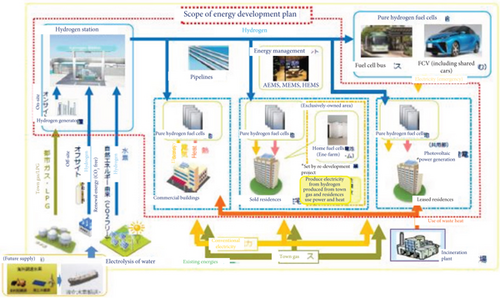
4.2.4. ECC Overload of 2020 Tokyo Olympic Games
Although the Tokyo Olympic Games issued a series of plans for sustainable development of events, the overload of ECC and adverse effects of ecological environment in the process of running the games were not uncommon. Bloomberg reported on July 14th, 2021, that residents near the competition venue complained that “Tokyo Bay stinks”, but in the subsequent broadcast of the competition, the water quality did look rather muddy. Before the official start of the competition, some athletes abandoned the competition because of the water quality of swimming pool, and some athletes vomited after landing from the swimming pool. The Tokyo Olympic Organizing Committee set unrealistic procurement standards for sustainable development, which further damaged the ecological environment. The American-based environmental organization Rainforest Action Network (RAN) found that some of the wood used in the construction of the venues of the 2020 Tokyo Olympic and Paralympic Games were cut down from the tropical forest containing the habitat of the endangered species orangutans. According to the report, the environmental protection organization confirmed that plywood manufactured by Indonesian enterprises was used in the construction site of Ariake Arena in 2018, and a number of related enterprises as supply sources were found in the nonpublic information. The environmental protection organization analyzed the situation of tropical forests in Kalimantan island managed by these enterprises, finding that in 2016 and 2017, when it was possible to supply timber to the venues, the forest area decreased by about 7,000 hectares in total.
4.2.5. Controversial Measures of Sustainable Development Plan of 2020 Tokyo Olympic Games
Many initiatives of thrifty competition in the sustainable development plan of Tokyo Olympic Games have been accused of being flashy. At the beginning of the preparation, the Tokyo Olympic Organizing Committee announced that the 3R concept of “Reduce,” “Reuse,” and “Recycle” should be regarded as one of the leading concepts of the Olympic Games. Among those comments, the 18,000 sets of cardboard beds in the Olympic Village were the most controversial topic. These beds, the first try in the history of the Olympic Games, were all made of recycled materials, which were put together like “paper boxes.” These cardboard beds caused many doubts in terms of safety, price, and comfort. However, it is estimated that the total price of the whole set of bedding is 150,000-250,000 yen (US $1400-2300). Moreover, all medals of this Olympic Games were unprecedentedly made of recycled electronic waste. In 2017, based on the concept of environmental protection, the Japanese government launched the collection activities of used mobile phone appliances. In more than two years, nearly 79,000 tons of small household appliances and 6.21 million old mobile phones were collected from the whole country, from which about 32 kilograms of pure gold, about 3,500 kilograms of pure silver, and about 2,200 kilograms of copper were extracted. Finally, all the medals of Tokyo Olympic Games were made with these recycled and refined metals. Tokyo took pride in applying recycled electronic waste to make gold medals. However, the gold medals were painted off just after the Olympic Games.
5. Summary
5.1. In Most Cases, the Host City of the Olympic Games Is under Great Ecological Carrying Pressure, and Attention Should Be Paid to the ECC of the Host City
Because of the particularity of the Olympic Games, most of the Olympic Games, especially the Summer Olympic Games, are almost held in the world’s megacities, and now the world’s megacities are under the pressure of ecological environment overload without exception. The investment in the Olympic Games is huge, and the period from the bid to the competition is often as long as 5-10 years. During the competition, tens of thousands of athletes, journalists and spectators will flood into the host city and the surrounding areas of sports venues in a short period of time. The transportation, accommodation, and energy consumption during this period will generate huge carbon emissions, which will easily cause huge ecological pressure on the host city. During the competition, the ecological burden of the host city is often overloaded, causing great difficulties for the postcompetition recovery. Therefore, at the beginning of the application, it is necessary to assess the ECC of the host city, make relevant plans, reduce carbon emissions, strive for carbon neutrality, and properly handle the problem of excessive ecological carrying pressure of the city caused by the competition.
5.2. The Sustainable Development of the Olympic Games Is an Important Issue in the Development of the Olympics, but the Sustainable Development Plan of the Olympics Is Still Being Explored
Sustainable development is an inevitable topic in the Olympics. In recent years, the Olympic Organizing Committee has issued a large number of documents on sustainable development. Whether it is the 2020 Tokyo Olympic Games or the 2022 Beijing Winter Olympics, the sustainable development plan is an important agenda. Relatively speaking, however, the sustainable development of the Olympics is still a new agenda, and there is still much room for improvement in terms of concept interpretation and practical operation. Especially in terms of frugality, it is necessary to avoid the appearance of “formal” frugality and “false” frugality. Starting from the purpose of hosting the Games and the actual situation of the host city, we should realistically introduce a scientific and achievable frugality scheme to further improve the sustainable development plan of the Olympic Games.
6. Suggestions
6.1. Full-Cycle Assessment of the Host City’s ECC
The ecological and environmental problems faced by the host city in the process of hosting the Olympic Games put forward a severe test on the supporting power of resource consumption, the degree of environmental pollution, and the ability of maintaining a certain living standard population. Any events that exceed the ECC will seriously affect the sustainable development of the city. Therefore, the ECC is an important basis to measure whether the urban environment is in harmony with the competition activities. Therefore, before the competition, we should strengthen the evaluation of the ECC of the competition and at the same time build a multifactor urban ECC estimation model related to the soil, water, atmosphere, and sound environment related to the competition, so as to comprehensively and quantitatively estimate the urban ECC and provide technical support for the construction of the evaluation system of urban ECC. Strengthen the monitoring of the ecological environment of the host city. The process of hosting the Olympic Games involves the reception of foreign tourists, the transportation of personnel and goods, the holding of the Olympic Games, the maintenance of venues and auxiliary facilities, etc., so that the eco-environmental stress factors in the host cities of the Olympic Games are characterized by multisource heterogeneity, complexity and variability, wide spatial and temporal distribution, large regional span, etc. Therefore, the eco-environmental monitoring in the process of hosting the Olympic Games should be based on diversified business databases. Focusing on the demand of early warning information of eco-environmental risks in the host cities, the relevant information in the fields of eco-environmental risk sources, atmosphere, soil, water, sound environment, etc. in the process of hosting the events will be integrated to form an environmental information database, and a complete eco-environmental risk monitoring system will be built to dynamically monitor the eco-environment of the host cities during the events. After the Games, strengthen the restoration and compensation of the host city’s ecological environment. After the Games, on the premise of following the principles of “ecological priority, sustainable development and equal rights and responsibilities” and according to the damage degree and present situation of the Olympic Games to the ecological environment, a reasonable ecological environment restoration scheme is formulated. Ecological compensation, as a benefit coordination and balance mechanism between the competition and the ecological environment, is the inevitable choice for the sustainable development of the Olympic Games and the urban ecological environment by constantly optimizing and adjusting the distribution relationship among stakeholders and realizing the mutually beneficial symbiosis among environmental protection actors.
6.2. Establish the Principle of Ecological Priority and Avoid the Overload Mode of Ecological Burden
To host the Olympic Games, the host cities generally put improving the ECC in the strategic height of sustainable development, which means that they should advocate green environmental protection, highlight green images, shape green brands, and establish the principle of ecological priority. The host cities should strictly enforce the environmental protection system, select the best control scheme, and control investment to reduce the air pollution around the city. It is also necessary to improve the quality of urban ecological environment and slow down the greenhouse effect and heat island effect in order to improve the natural environment and maintain the ecological balance. To host the Olympic Games, host cities need to avoid the overload mode evolved from the overload operation of bottleneck elements. Moreover, they can neither take the economic growth mode of excessive resource consumption and excessive environmental pollution nor stop or even sacrifice development to protect the resources and environment of the city. Instead, seeking the scientific, sustainable, and coordinated development is the only choice. Meanwhile, they should actively explore an effective development path in terms of improving the ECC of the city.
6.3. Strive to Achieve Carbon Neutrality during the Event
During the Olympic Games, the venues will gather a large number of people, producing all kinds of domestic garbage, leaving a variety of carbon footprints, and causing a heavy burden on the environment. At the same time, the venues will consume a lot of water, electricity, gas, and so on when emitting plenty of carbon. Facing these challenges, the host city can take carbon neutralization measures, such as energy saving and emission reduction technology, recycling, garbage sorting, etc., and strengthen the audience’s awareness of carbon neutralization in order to realize carbon neutralization in venues. Event organizers or venue managers should provide green travel, green catering, and other services as much as possible and reduce the carbon footprint during large-scale events by providing degradable products, using energy-saving and environmentally friendly and recyclable materials, reducing solid wastes and using disposable plastic products. The carbon neutrality of the competition can be understood as offsetting the carbon dioxide generated by the competition through energy saving and emission reduction technology or afforestation, so as to achieve the relative “zero emission” of carbon dioxide. For example, Beijing 2022 Winter Olympics and Winter Paralympics proposed to realize carbon neutrality and zero emission, and the concept of green and low carbon has been deeply integrated into the design, construction, and operation of venues, thus forming the accounting methodology of greenhouse gas emissions of Beijing Winter Olympics. The green and low carbon measures adopted will ensure the realization of carbon neutrality in the preparation and holding of the events. In the long run, the experience of carbon neutrality in Beijing 2022 Winter Olympics and Paralympic Winter Games will lead to the fulfillment of carbon neutrality.
6.4. Scientific Practice of Frugality in Running Competitions
Thrift is the guiding concept of the Olympic Games, and it cannot be rigidly required. As a large-scale public activity in modern society, sports events are held because of their great value. The objectives of the competition usually include political benefits, economic benefits, social benefits, etc. Focusing on these objectives, the host city should consider the integrity and coordination of resource management and form standards and scales for evaluating the efficiency of resource use, so as to measure the input and output effects of competition resources and implement frugal competition. This study draws a conclusion that thrifty competition should be started from the following three aspects: (1) Infrastructure construction and public facilities support. According to the idea of thrifty competition, the design of competition venues should adhere to the principles of practicality, intelligence, and green; optimize resource allocation by means of Internet and Internet of Things; and avoid budget overruns and environmental pollution. In terms of public facility support, the ideas of intelligence, green, and frugality should be followed, and modern logistics technology should be introduced to improve the operation efficiency of the transportation system with efficient, safe, timely, and reliable logistics operation. In terms of the scale and quantity of venue construction, it is necessary to transform and expand the existing stadium resources in the city and surrounding cities and gradually promote the preoperation concept of competition venues. Take Beijing Winter Olympic Games as an example. When bidding for the Winter Olympic Games, China has three major ideas, one of which is holding a thrifty Olympic Game. The most costly two aspects of the Beijing Winter Olympic Games are competition preparation (about US $1.56 billion) and venue construction (about US $1.51 billion), totaling about 3 billion US dollars, which is 1/5 of the 2018 PyeongChang Winter Olympics and 1/15 of the 2014 Sochi Winter Olympics. The biggest expense of the Olympic Games credits to infrastructure and venue construction; the overspending of the Olympic Games in the past proves the fact. Among the 12 competition venues of the Beijing Winter Olympics, five of them were the old venues of the 2008 Olympic Games, including the Bird’s Nest, the National Aquatics Center, and the Cadillac Arena, which can be directly transformed and reused. For example, the Bird’s Nest was used for holding the opening ceremony of the Beijing Winter Olympics again, and the National Aquatics Center was transformed into the Ice Cube. The total value of these venues exceeds 700 million yuan. The strategy of replacing the old with the new has helped Beijing save half of the venue construction fee. In addition, some hardware of BOCOG is leased directly to enterprises on a rental basis, which not only saves the cost but also reduces the later expenses. Through calculation, the mode of renting and purchasing can save more than 30% of equipment cost. Moreover,Organizing Committee use items to get funds. 65% of the $1.51 billion cost of venue construction comes from enterprise investment. For example, the Winter Olympic Village in the three major competition areas will be reused after the competition, in which Beijing and Zhangjiakou Olympic Village will be sold directly as commercial housing, while the Winter Olympic Village in Yanqing competition area will be transformed into a holiday hotel in scenic spots, as well as the National Alpine Ski Center and the National Ski Jumping Center, all of which will serve as tourist attractions after the competition. (2) Investment structure and operational efficiency. Investment structure and operation efficiency directly affect the benefit of running the competition. We should take advantage of the opportunity of the Olympic Games to guide the optimization and upgrading of the urban industrial structure, widen the width of the Olympic economy, arrange the Olympic investment reasonably, and promote the integration and development of the Olympic Games and cities. It is necessary to improve the operational efficiency of the Olympic Games; establish an all-round, multilevel, and multiechelon investment system; provide a good investment and financing environment; strengthen the supervision of funds; make overall arrangements for construction funds; optimize various forms of financing structures; strengthen project supervision; scientifically determine the scale of budget estimates; improve the scientificity of project design; improve the supervision and restraint mechanism; and ensure the clean and efficient preparation of the Olympic Games. For example, BOCOG’s budget for expenses is confidential and strictly reduces the construction cost. BOCOG’s budget for the preparation of events is based on the balance of payment strategy. The special funds of the IOC total 1.56 billion US dollars in sponsorship ticket revenue, brand authorization, and other income, just balancing the budget of 1.56 billion US dollars for the preparation of events. (3) Etiquette activity investment and personnel and organization control. Too much investment in etiquette activities, a huge number of staff and overstaffed organization have been bothering the organizers. Both the number of staff and organization of the Olympic Games and the input of the etiquette activities should under strict control. According to the actual needs of the events, we should deploy relevant personnel from all relevant units before the Games and arrange the number of staff and volunteers reasonably during the Games, so as to make every effort to embody the characteristics of the etiquette activities without causing great waste. For example, the training venues of rugby and rock climbing in the 2022 Hangzhou Asian Games were transformed from the existing sports venues in Zhejiang College of Construction, and the operation team of the venues was mainly composed of personnel from the unit where the venues were located. After the renovation of the original track and field and rock climbing ground in Zhejiang College of Construction as the Asian Games venues, it not only saved the expenses for building venues but also took advantage of the opportunity of hosting the international Olympic Games to improve the level of sports hardware facilities and the professional level of venue managers in colleges and universities. While meeting the needs of the competition, it avoided the huge expenses caused by newly built venues, effectively integrated the existing resources, which not only saved a lot of funds but also met the requirements of the Asian Games. Furthermore, it can serve tens of thousands of students with high standards after the Games, achieving the dual goals of high-quality and thrifty Games, promoting the integration and development of the Olympic Games and university sports resources, and perfectly practicing the idea of “thrifty Games” in the 2022 Hangzhou Asian Games.
Conflicts of Interest
The authors declared that they have no conflicts of interest regarding this work.
Acknowledgments
This research study is sponsored by the General Project of 2020 Zhejiang Philosophy and Social Science Planning: “Thrift Management” Model of Large-Scale Sports Events and Enlightenment to Hangzhou Asian Games (Project No. 20NDJC226YB), the Second Batch of Teaching Reform Research Projects of Higher Education in Zhejiang Province during the “Thirteenth Five-Year Plan”: Research on the Integration of College Sports Resources and Large-Scale Sports Events (Project No. jg20190836), and the 2021 Zhejiang College of Construction Technology Innovation Team: Asian Olympic Culture Research Team (No. 2021.45.9B).
Open Research
Data Availability
The data used to support the findings of this study are included within the article.




